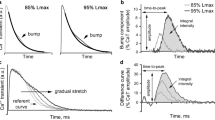Abstract
End-stage failing human myocardium is characterized by a negative force-frequency relationship (FFR), possibly as a result of reduced SR Ca2+ uptake capacity. We investigated the effects of the direct adenylate cyclase stimulator, forskolin, on force of contraction and FFR in isolated human myocardium from 7 nonfailing hearts (NF) and end-stage failing hearts (NYHA IV) due to either ischemic (ICM; n=13) or dilated cardiomyopathy (DCM; n=16).
Methods: Isolated left ventricular muscle strips, isometric contraction, electrical stimulation at a basal stimulation rate of 1 Hz (37°C). Inotropic responses: Cumulative concentration-response curves for forskolin (0.01–10 μM) and for Ca2+ (2.5–15 μM). Force-frequency experiments: stepwise increase in stimulation rate from 0.5 to 3.0 Hz without and in the presence of 0.3, 1.0 or 3.0 μM forskolin.
Results: Forskolin concentration – dependently increased force of contraction to 386±28% (n=5) in NF, to 256±48% (n=7) in ICM, and to 212±13% (n=14) in DCM. The effectiveness of forskolin was significantly reduced in failing myocardium. Ca2+ increased force of contraction to maximally 438±108% in NF, to 267±15% in ICM, and to 292±20% in DCM. Again, the effectiveness of Ca2+ was significantly reduced in failing myocardium. Forskolin activated contractile reserve to similar extents in all types of myocardium (90%, 95%, and 82%, respectively). Force of contraction continuously increased with increasing stimulation rates in nonfailing myocardium (positive FFR), but was blunted or inversed in ICM and DCM. Prestimulation with forskolin (0.3 μM) further enhanced frequency-potentiation in nonfailing, and normalized the slope and optimum stimulation frequency in ICM and DCM. However, at higher concentration of forskolin, FFR was blunted or inversed in nonfailing myocardium, and further impaired in failing myocardium.
Conclusion: Low concentrations of forskolin with only marginal inotropic effects may partially normalize the inverse force-frequency relation in end-stage failing human myocardium. Reduced cAMP levels in conjunction with reduced expression of SR Ca2+ ATPase may be the underlying cause for altered excitation-contraction coupling in diseased human hearts.
Similar content being viewed by others
Author information
Authors and Affiliations
Rights and permissions
About this article
Cite this article
Pieske, B., Trost, S., Schütt, K. et al. Influence of Forskolin on the force-frequency behavior in nonfailing and end-stage failing human myocardium. Basic Res Cardiol 93 (Suppl 1), s066–s075 (1998). https://doi.org/10.1007/s003950050222
Issue Date:
DOI: https://doi.org/10.1007/s003950050222




